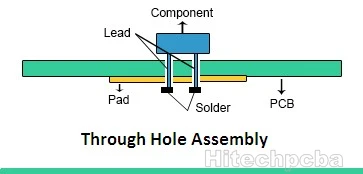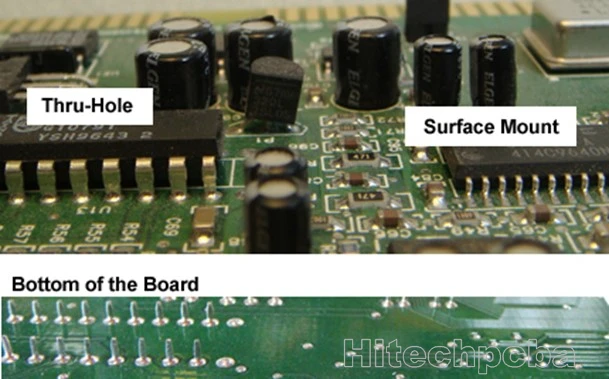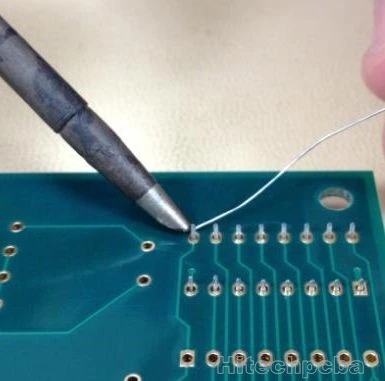What is Through-hole PCB Assembly?
What is Through-hole PCB Assembly?
In through hole PCB assembly, the components are mounted on the PCB board by inserting their leads/terminals in holes that are already drilled through the PCB board. These terminals are then soldered manually or through reflow soldering to hold the component in place and connect it to the conductive path. One key thing to note about Thru-hole assembly is that it is not very efficient for multi-layer PCBs as it takes up board space on every layer. As a result, this type of assembly is usually found on single-layer PCBs.

The Through Hole Soldering technique was the primary method which was used to add components on a PCB till the emergence of Surface Mount Technology. Components soldered using the Surface Mount Soldering technique (SMT) do not have leads and can be directly mounted on the surface of the PCB. In addition to this, the components of SMT are smaller in size and can be mounted on both sides of the board.
The Through Hole Soldering technique requires the drilling of holes onto the PCB through which the leads can be inserted and can be soldered to the other side of the board. As a result, this process can be more expensive and time-consuming when compared to using Surface Mount soldering techniques.
Through-hole Soldering techniques are still used for testing and prototyping. They can also be used in environments that have high mechanical and thermal stress, as the leads going through the board provides a stable structure. However, most applications today use surface mount soldering techniques.
Through Hole Technology (THT) is a method of assembling electronic components onto a printed circuit board (PCB) by inserting the leads of the component into drilled holes in the PCB and soldering the leads to the pads on the other side. This creates a permanent connection between the component and the board.
The process of THT typically involves drilling holes in the PCB, inserting the component leads into the holes, and then soldering the leads to the pads on the other side of the board. Thus, it creates a strong mechanical and electrical connection between the component and the board, making THT an ideal choice for high-reliability and durability applications.

One of the key benefits of THT is its ability to handle high-power components, making it an ideal choice for power electronics applications. THT components can also handle high temperatures and vibrations, making it an ideal choice for harsh environments. The process of THT is also relatively straightforward, making it a cost-effective option for manufacturers.
Advantages of Through-hole PCB Assembly:
Highly Reliable: Components mounted on a PCB Board using Through-hole assembly (THA) can withstand a high level of environmental stress as their terminals go through the drilled holes followed by soldering. This is the primary reason why Thru-Hole PCB boards are widely used in Military & Aerospace products as they tolerate extreme acceleration and collision scenarios.
Manual adjustments can be performed easily: Defective components on PCB boards can be changed very easily. In other assembly processes like Surface Mount, it is not easy.
Limitation of Through-hole PCB Assembly:
Space Limitation: Through-hole mounting also reduces the available routing space in a multi-layer PCB since drilled holes go through all the layers and take more space in each layer of the board.
Through Hole Component Types
Through Hole Soldering requires axial or radial components with leads.
Axial Components: Axial leads run through a component in a straight line with each end of the wire attached to the component.
article-image
Some examples of Axial Components:
Resistors
Carbon film resistors
Diodes
Inductors
Capacitors
Radial Components: Radial leads are placed parallel to each other from the surface of the component. When Radial Leads along with their components are placed on a board, they are positioned perpendicularly to the board occupying lesser space making them useful in high-density applications.
article-image
Some examples of Radial Components:
MOSFETs
LEDs
RGBs
Photoresistors
Photodiodes
Ceramic Capacitors
Steps to Perform Through Hole Soldering:
Step 1: Cleaning the PCB and Components:
The PCB and the electronic components are first cleaned with isopropyl alcohol and then wiped dry. The PCB must be free of dirt or dust.
Step 2: Bend the Leads
Bend the Leads
If an Axial Component is used for mounting onto the PCB they are bent initially using a plier so that they fit perfectly onto the PCB. If a radial component is being used it can be inserted directly into the holes of the PCB.
Step 3: Place the Component and Cut the Leads
Place the Part and Cut the Leads
After the electric component is bent, they are then inserted into the holes of the PCB according to the design schematics and excess lead is cut-off. It must be observed that the component lies flat on the PCB
Step 4: Soldering

Apply Flux and Solder
The Important rule for through-hole soldering is that the flux can be applied to both sides of the board, but the solder must be applied to only one side. Applying FLUX to both sides of the PCB will help keep the soldering area clean and help with heat conduction. One must ensure to apply solder only to the underside of the board.
Step 5: Clean & Inspect
Clean and Inspect
Clean and inspect the final product to ensure there are no irregularities. The Solder must be shiny in colour and the component must be held onto its place on the printed circuit board.
Click here to see a list of PCB Assembly companies that do Thru-Hole Assembly.

0086-755-29970700
sales@hitechpcb.com; sales@hitechcircuits.com
3F, B5 Dong, Zhimeihuizhi, FuYong, Bao’an Dist. Shenzhen, GuangDong, China 518103
 Chinese
Chinese English
English Russian
Russian Spanish
Spanish Portuguese
Portuguese





